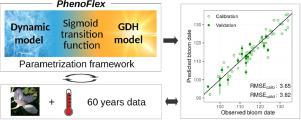Agricultural and Forest Meteorology ( IF 6.2 ) Pub Date : 2021-06-06 , DOI: 10.1016/j.agrformet.2021.108491 Eike Luedeling , Katja Schiffers , Till Fohrmann , Carsten Urbach

|
Forecasting spring phenology of temperate fruit trees is of high concern for orchard plannersand fruit producers, particularly in the context of climate change. Responding to this need, horticultural researchers have developed models to estimate chill and heat requirements and project dormancy release. Despite some successes in dormancy modeling, several shortcomings still hamper reliable forecasts. Many widely used models rely on oversimplified and inflexible assumptions and are neither validated nor parameterized for most species or cultivars. More complex models are often poorly accessible due to a lack of guidance on calibration and application. Moreover, most approaches do not provide estimates of uncertainty. We aimed to develop a dormancy model that (a) is based on the best available biological understanding and experimental evidence on dormancy dynamics, (b) can flexibly adapt to species- and cultivar-specific physiology, (c) comes with a detailed description of the work-flow and (d) is open-source. The result is the new modeling framework PhenoFlex. It combines the Dynamic Model for chill accumulation with the Growing-Degree-Hours model for heat accumulation by a flexible transition. PhenoFlex is accompanied by a framework for calibrating the 12 model parameters. It is published as part of the chillR package, which contains a detailed vignette. We tested the predictive performance of PhenoFlex with 60 years of apple and pear bloom data and compared results to several benchmark models. With Root Mean Square Error values for projected bloom dates of 4.0 days for pears and 3.8 days for apples, PhenoFlex outperformed all other models including the StepChill model (10.2 and 7.7 days, respectively), and a machine learning approach (5.6 and 6.3 days). Some temperature response dynamics appeared unrealistic, indicating the need for larger training datasets with more temperature variation. We hope that PhenoFlex will facilitate further research on the temperature response dynamics of temperate tree species.
中文翻译:

PhenoFlex - 预测温带果树春季物候的综合模型
预测温带果树的春季物候是果园规划者和水果生产者高度关注的问题,尤其是在气候变化的背景下。为响应这一需求,园艺研究人员开发了模型来估计冷热需求和项目休眠释放。尽管在休眠建模方面取得了一些成功,但仍有一些缺点阻碍了可靠的预测。许多广泛使用的模型依赖于过于简单和不灵活的假设,并且对于大多数物种或栽培品种既没有经过验证也没有参数化。由于缺乏校准和应用方面的指导,更复杂的模型通常难以访问。此外,大多数方法不提供不确定性的估计。我们旨在开发一个休眠模型,该模型(a)基于休眠动力学的最佳可用生物学理解和实验证据,(b)可以灵活地适应物种和品种特定的生理学,(c)附带详细描述工作流程和 (d) 是开源的。结果是新的建模框架 PhenoFlex。它通过灵活的转换将冷气积聚的动态模型与热量积聚的 Growing-Degree-Hours 模型相结合。PhenoFlex 附带一个用于校准 12 个模型参数的框架。它作为 chillR 包的一部分发布,其中包含详细的插图。我们用 60 年的苹果和梨开花数据测试了 PhenoFlex 的预测性能,并将结果与几个基准模型进行了比较。梨的预计开花日期为 4.0 天,苹果为 3.8 天,PhenoFlex 的均方根误差值优于所有其他模型,包括 StepChill 模型(分别为 10.2 天和 7.7 天)和机器学习方法(5.6 天和 6.3 天) . 一些温度响应动态看起来不切实际,表明需要更大的温度变化更大的训练数据集。我们希望 PhenoFlex 将有助于进一步研究温带树种的温度响应动力学。表明需要更大的温度变化更大的训练数据集。我们希望 PhenoFlex 将有助于进一步研究温带树种的温度响应动力学。表明需要更大的温度变化更大的训练数据集。我们希望 PhenoFlex 将有助于进一步研究温带树种的温度响应动力学。


























 京公网安备 11010802027423号
京公网安备 11010802027423号